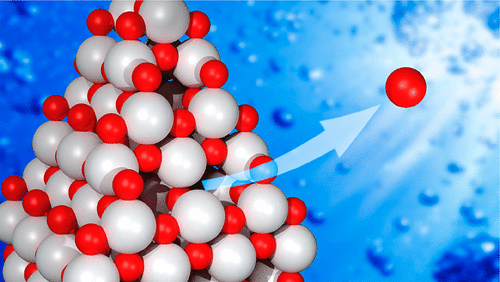当前位置:
X-MOL 学术
›
J. Phys. Chem. C
›
论文详情
Our official English website, www.x-mol.net, welcomes your
feedback! (Note: you will need to create a separate account there.)
Properties of Single Oxygen Vacancies on a Realistic (TiO2)84 Nanoparticle: A Challenge for Density Functionals
The Journal of Physical Chemistry C ( IF 3.3 ) Pub Date : 2018-01-17 00:00:00 , DOI: 10.1021/acs.jpcc.7b11269 Ángel Morales-García 1 , Oriol Lamiel-García 1 , Rosendo Valero 1 , Francesc Illas 1
The Journal of Physical Chemistry C ( IF 3.3 ) Pub Date : 2018-01-17 00:00:00 , DOI: 10.1021/acs.jpcc.7b11269 Ángel Morales-García 1 , Oriol Lamiel-García 1 , Rosendo Valero 1 , Francesc Illas 1
Affiliation

|
Based on all electron relativistic density functional theory calculations, the properties of single oxygen vacancies in TiO2 nanoparticles (NPs) have been obtained using a suitable representative model consisting of an octahedral (TiO2)84 nanoparticle of ∼3 nm size terminated with (101) facets. This nanoparticle can be safely considered at the onset of the so-called scalable regime where properties scale linearly with size toward bulklike limit, and hence results can be more directly compared to experiment. A set of reduced Ti84O167 nanoparticles are selected to investigate the geometric, energetic, and electronic properties by using PBE semilocal functional with three different amounts of Fock exchange: 0% (PBE), 12.5% (PBEx), and 25% (PBE0). In particular, using the PBEx hybrid functional, previously validated for bulk anatase and rutile, it is predicted that the highly (three)-coordinated oxygen atom, located in the subsurface, and the least coordinated one at top sites are energetically the most suitable candidate for generating the oxygen vacancy. The subsurface case is in line with conclusions from experiments carried out on (101) single crystal anatase surfaces. The electronic structure of the reduced particles suggests that these would have better photocatalytic activity than their stoichiometric counterparts. Nevertheless, several properties of reduced TiO2 NPs are strongly affected by the choice of the exchange-correlation functional, implying that, in absence of validation by comparison to experiment, predictions must be taken with caution.
中文翻译:

现实的(TiO 2)84纳米粒子上的单氧空位的性质:对密度功能的挑战
基于所有电子相对论密度泛函理论计算,使用合适的代表性模型获得了TiO 2纳米颗粒(NPs)中单氧空位的性质,该模型由〜3 nm尺寸的八面体(TiO 2)84纳米颗粒组成,终止于(101) )方面。可以在所谓的可扩展方案开始时安全地考虑该纳米颗粒,在该方案中,属性随着大小朝着类似体的极限线性地缩放,因此可以将结果与实验进行更直接的比较。一组还原的Ti 84 O 167通过使用具有三种不同Fock交换量的PBE半局部功能,选择纳米颗粒以研究几何,能量和电子性质:0%(PBE),12.5%(PBEx)和25%(PBE0)。特别是,使用PBEx杂合官能团(先前已验证过大量的锐钛矿和金红石),可以预测位于地下的(高度)(三个)配位的氧原子和位于顶部位点的配位最少的氧原子在能量上是最合适的候选者用于产生氧气空位。地下情况与在(101)单晶锐钛矿表面上进行的实验得出的结论一致。还原颗粒的电子结构表明,它们的化学催化活性比其化学计量的对应物更好。然而,还原钛的一些特性2个NP受交换相关功能的选择强烈影响,这意味着,在没有与实验比较的情况下进行验证时,必须谨慎进行预测。
更新日期:2018-01-17
中文翻译:

现实的(TiO 2)84纳米粒子上的单氧空位的性质:对密度功能的挑战
基于所有电子相对论密度泛函理论计算,使用合适的代表性模型获得了TiO 2纳米颗粒(NPs)中单氧空位的性质,该模型由〜3 nm尺寸的八面体(TiO 2)84纳米颗粒组成,终止于(101) )方面。可以在所谓的可扩展方案开始时安全地考虑该纳米颗粒,在该方案中,属性随着大小朝着类似体的极限线性地缩放,因此可以将结果与实验进行更直接的比较。一组还原的Ti 84 O 167通过使用具有三种不同Fock交换量的PBE半局部功能,选择纳米颗粒以研究几何,能量和电子性质:0%(PBE),12.5%(PBEx)和25%(PBE0)。特别是,使用PBEx杂合官能团(先前已验证过大量的锐钛矿和金红石),可以预测位于地下的(高度)(三个)配位的氧原子和位于顶部位点的配位最少的氧原子在能量上是最合适的候选者用于产生氧气空位。地下情况与在(101)单晶锐钛矿表面上进行的实验得出的结论一致。还原颗粒的电子结构表明,它们的化学催化活性比其化学计量的对应物更好。然而,还原钛的一些特性2个NP受交换相关功能的选择强烈影响,这意味着,在没有与实验比较的情况下进行验证时,必须谨慎进行预测。










































 京公网安备 11010802027423号
京公网安备 11010802027423号